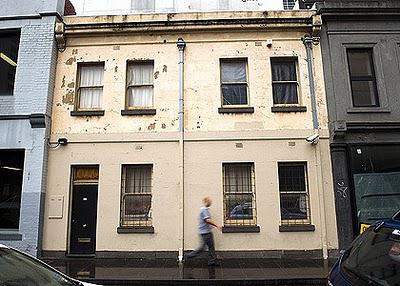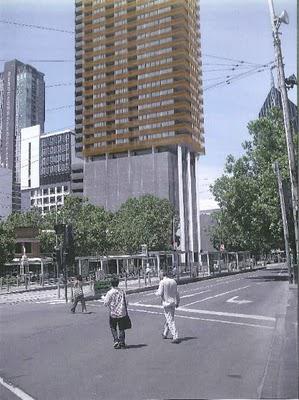Heritage Lost in a Forest of TowersRohan Storey (National Trust)The Age - Opinion - 19 November 2010(Pictures and captions added by me)

Plans for the Celtic Club (1890) to be mostly demolished and a 40-storey tower added
Watered-downcontrols mean the city's past is overshadowed or gone. As a youngheritage activist in 1990, I was shocked by the demolition of old citybuildings, which I had taken for granted as protected, such as the art decoAustralia Hotel.Through thatinterest I ended up with a job at the NationalTrust, and I'm still there. Soon I came to understand and appreciatethe rich heritage of the CBD, and the planning controls then in force.The ''vision''was pretty straightforward, and tailored to Melbourne's unique built-form character.Most importantly, areas such as Chinatown, Flinders Lane, Hardware Street andBourke Hill were protected as heritage areas or by height limits, such as the40-metre height limit over the central shopping area along Swanston Street,packed with heritage buildings.Heritage valuewould be considered for all ''graded'' buildings, and they would be generallyretained, not reduced to a facade. (The loss of the Australia Hotel turned outto be a glaring exception.)Largedevelopments were to have low podiums at street level, with any tower abovewell setback, so as not to dominate the street or adjacent heritage buildings.The basic control for these was a bonus system, in which the maximum floor areadepended on the size of the site (the ''plot ratio'') and could be increasedthrough providing benefits as such as heritage restoration, a new arcade, orbluestone footpaths. The bonus system is commonly used in modern Westerncities, including London, San Francisco and even New York, the home of theskyscraper. This was allestablished by the Cain government in the early 1980s, and was supportedthrough to the early '90s by the Melbourne City Council. But it was greatlyundermined in 1997 as part of the Kennett-era reorganisation of localgovernment and planning.
The new rulesfor the CBD kept most of the words of the ''vision'', but made nearlyeverything ''discretionary''; plot ratio became just one of many preferred''outcomes'', with no bonus system. The podium-setback rules, retention oflight to the streets and even height limits became just items on a list of''preferred built-form outcomes''. Heritage value would not be consideredunless the place had a ''heritage overlay'', and outside the precincts this wasbased on a list created in 1982.

Terraces from 1870s can be demolished at any time, despite their historical significance.
The only mandatorycontrol remaining in the CBD is the 40-metre height limit protecting thecentral retail area - the lanes and arcades are now stuffed with the ever morepopular bars and cafes occupying the numerous heritage buildings.The rest of thecity has not been so lucky; after years of creeping concessions, the old visionis all but dead. Senior planners now openly admit they no longer consider plotratio and apartment towers are blossoming like toadstools after rain. What'smore, they are clustering together with barely room to swing the proverbialcat, rising straight from the ground and replacing heritage buildings thatshould have been listed years ago.The northernfringe of the city and the ''little'' streets are fertile ground; there areseven towers of more than 40 storeys under way or permitted between Elizabethand Swanston streets, north of La Trobe. Franklin Street is now decidedlygloomy in the winter months. The Melbourne City Council has been wringing itshands recently that Southbank is getting to be too much like Hong Kong - but atthe other end of the city Hong Kong has already arrived.
The Stork Hotel (1855) was recently demolished to soon accommodate this
67-storey tower.

